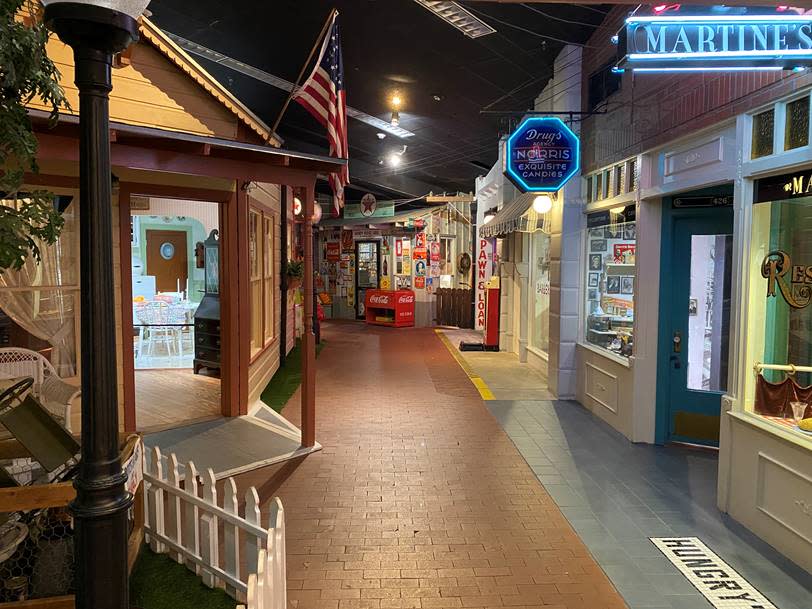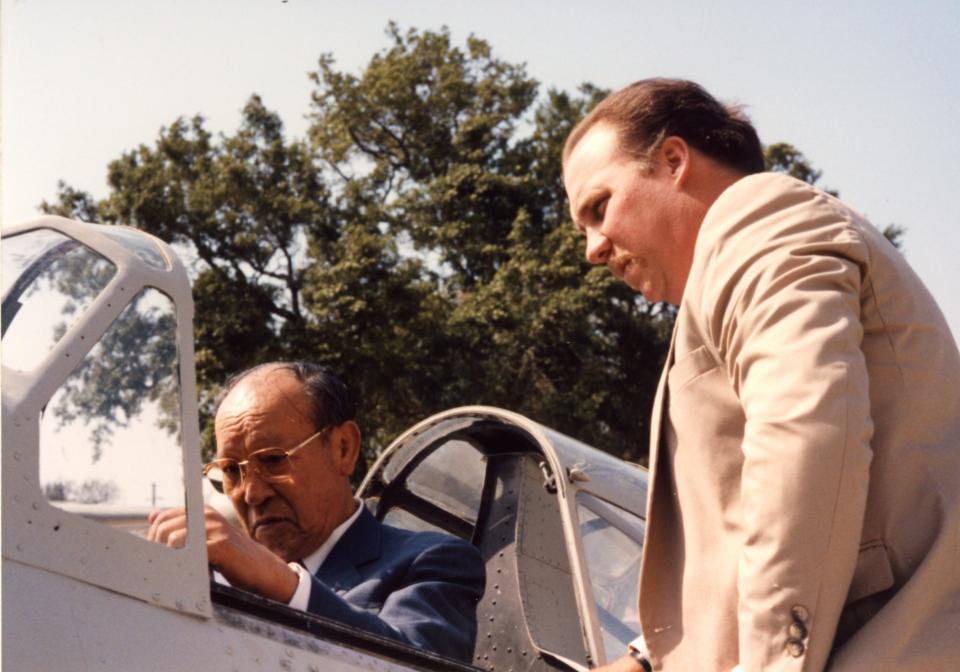National Naval Aviation Museum exhibits shaped by boy inspired on beaches of Guam
- Oops!Something went wrong.Please try again later.
For Robert R. Macon, known to his friends and co-workers as Buddy, the road to a 32-year career as the Deputy Director of the National Naval Aviation Museum began on Guam. The son of a U.S. Air Force master sergeant assigned to Andersen AFB during the 1960s, he wandered the landscape of the island that just two decades earlier had been the scene of a major World War II battle. Seeing firsthand the detritus of war from shattered landing craft to discarded equipment inspired an interest in collecting military memorabilia.
Returning to his parents’ hometown of Pensacola, he graduated from Escambia High School and then Florida State University, expecting to embark on a career as a teacher and coach. Instead, he turned to a career in the legal profession, graduating from the Birmingham School of Law in Alabama and setting up a practice there. An opportunity to enter the federal workforce brought him back to Pensacola for a job as a labor relations attorney. Among the commands he covered was the then-U.S. Naval Aviation Museum.
One day, museum director CAPT Bob Rasmussen, USN (Ret.) visited Macon in his office and noted some military artifacts on display. Realizing an opportunity to add someone to the museum staff with a knowledge of history and his labor force, Rasmussen offered him a job and in November 1990 Buddy became the first incumbent of the newly created post of deputy director, which also included duties as the senior curator.
Exhibit:New monument at Pensacola Navy museum honors Marine Corps electronic warfare squadrons
NAS Pensacola access:Calls to restore NAS Pensacola access are growing and supporters want Washington to notice
Buddy, now retired, arrived at a pivotal moment in the museum’s history, one marked by physical expansion and a burgeoning program of underwater aircraft recovery from Lake Michigan. Almost immediately, Buddy began to transform how the museum told the story of Naval Aviation, taking steps to create what have become some of the museum’s most enduring and popular exhibits. By summer 1991 the idea for a display depicting some of the aircraft wrecks in their underwater state had taken shape in his mind. Though the initial concept of actually having a giant indoor aquarium in which to immerse the aircraft proved too costly, using some lights shone through running water created the desired effect and the exhibit “Underwater Treasures” remains a popular experience for visitors.

More:Presidents, battles and fictional Shangri-La: Where Navy aircraft carriers get their names
Another longtime museum fixture got its start as an entry in a contest for best exhibit at the Pensacola Interstate Fair in the early 1990s. While the multiple aircraft displayed around the museum told a technological tale, the new deputy director knew that the personal stories were what resonated with most visitors. Thus, he set out to create a World War II Pacific Island scene complete with period flight gear and wartime Americana. With ensigns waiting to start flight school volunteering to serve as actors interacting with visitors, the exhibit won first prize.
Capitalizing on its popularity, it became a permanent exhibit on the mezzanine of the museum and expanded to become part of a series of popular dioramas. They include perhaps Buddy’s most popular creation, “Home Front U.S.A,” that recreates a Pensacola street scene during World War II. From taking in the vintage products in the grocery store to listening to Red Barber calling the 1943 Major League baseball All-Star game on the radio, hundreds of thousands of visitors have strolled down the street into the nation’s past.

It is safe to say that virtually every exhibit in the museum has Buddy’s fingerprints on it, to include the monument at the museum entrance. One day, noticing a group of old-timers (which included a World War I era aviator) talking with their hands in the universal language of pilots, he thought a scene depicting aviators from respective eras in history sharing stories would tell a dramatic story. Rasmussen used his artistic skills to sketch out a concept and in 1994 the “Spirit of Naval Aviation” by Sandra Van Zandt was unveiled at the Smithsonian’s National Air and Space Museum before traveling to its home in Pensacola.
His observance of the gathering of aviators is not surprising for Buddy always appreciated the people he met during his tenure, many of whom appeared in the pages of history. One of the first tours he conducted was for retired RADM Henry Miller, who as a young pilot taught the Doolittle Raiders how to launch from a short distance in preparation for their historic mission from USS Hornet (CV 8). Another enduring memory was experiencing the moment when former Japanese fighter pilot Sadamu Komachi climbed into the museum’s example of the Japanese Zero, the first time he had sat in the cockpit of one of the famed aircraft since World War II. From astronauts to POWs to members of the famed “Flying Tigers,” he crossed paths with legends.
His appreciation for people extended to the museum staff. From providing opportunities to college students seeking a career in the museum field to recruiting talent from other Navy commands, he played a major role in building the professional staff of the museum into what it is today. Current museum director CAPT Sterling Gilliam, USN (Ret.) states it well. “The team Buddy Macon put on the field is second to none. Talented, resourceful and above all dedicated, this group of professionals oversaw the explosive expansion of a local attraction into the third largest aviation museum in the world.”
In a story he enjoyed telling through the years, on the weekend before reporting for his first day on the job, Buddy came out to the museum to walk around. Seeking to get a closer look at an airplane, he was peering into the cabin of the Ford Tri-Motor when he heard a voice admonishing him to get away from the airplane. Seeing a museum volunteer, he explained that he was the new deputy director, receiving a curt response telling him that it didn’t matter who he was, he needed to get away from the airplane. That was the first and last time that someone in the museum did not recognize him, and anyone who sets foot in the National Naval Aviation Museum today enters a place shaped in many ways by the young boy inspired on the beaches of Guam.
This article originally appeared on Pensacola News Journal: National Naval Aviation Museum exhibits are passion of deputy director

